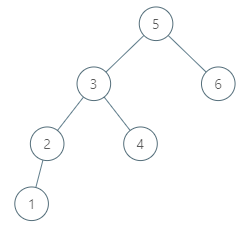[LeetCode] Inorder Successor in BST II 二叉搜索树中的中序后继节点之二
Given a binary search tree and a node in it, find the in-order successor of that node in the BST.
The successor of a node p is the node with the smallest key greater than p.val.
You will have direct access to the node but not to the root of the tree. Each node will have a reference to its parent node.
Example 1:
Input:
root = {"$id":"1","left":{"$id":"2","left":null,"parent":{"$ref":"1"},"right":null,"val":1},"parent":null,"right":{"$id":"3","left":null,"parent":{"$ref":"1"},"right":null,"val":3},"val":2}
p = 1
Output: 2
Explanation: 1's in-order successor node is 2. Note that both p and the return value is of Node type.
Example 2:
Input:
root = {"$id":"1","left":{"$id":"2","left":{"$id":"3","left":{"$id":"4","left":null,"parent":{"$ref":"3"},"right":null,"val":1},"parent":{"$ref":"2"},"right":null,"val":2},"parent":{"$ref":"1"},"right":{"$id":"5","left":null,"parent":{"$ref":"2"},"right":null,"val":4},"val":3},"parent":null,"right":{"$id":"6","left":null,"parent":{"$ref":"1"},"right":null,"val":6},"val":5}
p = 6
Output: null
Explanation: There is no in-order successor of the current node, so the answer isnull.
Example 3:
Input:
root = {"$id":"1","left":{"$id":"2","left":{"$id":"3","left":{"$id":"4","left":null,"parent":{"$ref":"3"},"right":null,"val":2},"parent":{"$ref":"2"},"right":{"$id":"5","left":null,"parent":{"$ref":"3"},"right":null,"val":4},"val":3},"parent":{"$ref":"1"},"right":{"$id":"6","left":null,"parent":{"$ref":"2"},"right":{"$id":"7","left":{"$id":"8","left":null,"parent":{"$ref":"7"},"right":null,"val":9},"parent":{"$ref":"6"},"right":null,"val":13},"val":7},"val":6},"parent":null,"right":{"$id":"9","left":{"$id":"10","left":null,"parent":{"$ref":"9"},"right":null,"val":17},"parent":{"$ref":"1"},"right":{"$id":"11","left":null,"parent":{"$ref":"9"},"right":null,"val":20},"val":18},"val":15}
p = 15
Output: 17
Example 4:
Input:
root = {"$id":"1","left":{"$id":"2","left":{"$id":"3","left":{"$id":"4","left":null,"parent":{"$ref":"3"},"right":null,"val":2},"parent":{"$ref":"2"},"right":{"$id":"5","left":null,"parent":{"$ref":"3"},"right":null,"val":4},"val":3},"parent":{"$ref":"1"},"right":{"$id":"6","left":null,"parent":{"$ref":"2"},"right":{"$id":"7","left":{"$id":"8","left":null,"parent":{"$ref":"7"},"right":null,"val":9},"parent":{"$ref":"6"},"right":null,"val":13},"val":7},"val":6},"parent":null,"right":{"$id":"9","left":{"$id":"10","left":null,"parent":{"$ref":"9"},"right":null,"val":17},"parent":{"$ref":"1"},"right":{"$id":"11","left":null,"parent":{"$ref":"9"},"right":null,"val":20},"val":18},"val":15}
p = 13
Output: 15
Note:
- If the given node has no in-order successor in the tree, return
null. - It's guaranteed that the values of the tree are unique.
- Remember that we are using the
Nodetype instead ofTreeNodetype so their string representation are different.
Follow up:
Could you solve it without looking up any of the node's values?
这道题是之前的那道 Inorder Successor in BST 的后续,之前那道题给了我们树的根结点,而这道题并没有确定给我们根结点,只是给了树的任意一个结点,然后让求给定结点的中序后继结点。这道题比较好的一点就是例子给的比较详尽,基本覆盖到了大部分的情况,包括一些很 tricky 的情况。首先来看例子1,结点1的中序后继结点是2,因为中序遍历的顺序是左-根-右。还是例子1,结点2的中序后续结点是3,这样我们就知道中序后续结点可以是其父结点或者右子结点。再看例子2,结点6的中序后续结点是空,因为其已经是中序遍历的最后一个结点了,所以没有后续结点。例子3比较 tricky,结点 15 的中序后续结点不是其右子结点,而是其右子结点的左子结点 17,这样才符合左-根-右的顺序。例子4同样 tricky,结点 13 的中序后继结点并不是其亲生父结点,而是其祖爷爷结点 15。
好,看完了这四个例子,我们应该心里有些数了吧。后继结点出现的位置大致可以分为两类,一类是在子孙结点中,另一类是在祖先结点中。仔细观察例子不难发现,当某个结点存在右子结点时,其中序后继结点就在子孙结点中,反之则在祖先结点中。这样我们就可以分别来处理,当右子结点存在时,我们需要找到右子结点的最左子结点,这个不难,就用个 while 循环就行了。当右子结点不存在,我们就要找到第一个比其值大的祖先结点,也是用个 while 循环去找即可,参见代码如下:
解法一:
class Solution {
public:
Node* inorderSuccessor(Node* node) {
if (!node) return nullptr;
Node *res = nullptr;
if (node->right) {
res = node->right;
while (res && res->left) res = res->left;
} else {
res = node->parent;
while (res && res->val < node->val) res = res->parent;
}
return res;
}
};
本题的 Follow up 让我们不要访问结点值,那么上面的解法就不行了。因为当 node 没有右子结点时,我们没法通过比较结点值来找到第一个大于 node 的祖先结点。虽然不能比较结点值了,我们还是可以通过 node 相对于其 parent 的位置来判断,当 node 是其 parent 的左子结点时,我们知道此时 parent 的结点值一定大于 node,因为这是二叉搜索树的性质。若 node 是其 parent 的右子结点时,则将 node 赋值为其 parent,继续向上找,直到其 parent 结点不存在了,此时说明不存在大于 node 值的祖先结点,这说明 node 是 BST 的最后一个结点了,没有后继结点,直接返回 nullptr 即可,参见代码如下:
解法二:
class Solution {
public:
Node* inorderSuccessor(Node* node) {
if (!node) return nullptr;
if (node->right) {
node = node->right;
while (node && node->left) node = node->left;
return node;
}
while (node) {
if (!node->parent) return nullptr;
if (node == node->parent->left) return node->parent;
node = node->parent;
}
return node;
}
};
Github 同步地址:
https://github.com/grandyang/leetcode/issues/510
类似题目:
参考资料:
https://leetcode.com/problems/inorder-successor-in-bst-ii/
LeetCode All in One 题目讲解汇总(持续更新中...)
[LeetCode] Inorder Successor in BST II 二叉搜索树中的中序后继节点之二的更多相关文章
- [LeetCode] Inorder Successor in BST 二叉搜索树中的中序后继节点
Given a binary search tree and a node in it, find the in-order successor of that node in the BST. No ...
- [LeetCode] 285. Inorder Successor in BST 二叉搜索树中的中序后继节点
Given a binary search tree and a node in it, find the in-order successor of that node in the BST. Th ...
- [Swift]LeetCode285. 二叉搜索树中的中序后继节点 $ Inorder Successor in BST
Given a binary search tree and a node in it, find the in-order successor of that node in the BST. Th ...
- 给定一个二叉搜索树的根节点 root 和一个值 key,删除二叉搜索树中的 key 对应的节点,并保证二叉搜索树的性质不变。返回二叉搜索树(有可能被更新)的根节点的引用
一般来说,删除节点可分为两个步骤: 首先找到需要删除的节点: 如果找到了,删除它. 说明: 要求算法时间复杂度为 O(h),h 为树的高度. 示例: root = [5,3,6,2,4,null,7] ...
- [Swift]LeetCode450. 删除二叉搜索树中的节点 | Delete Node in a BST
Given a root node reference of a BST and a key, delete the node with the given key in the BST. Retur ...
- Java实现 LeetCode 450 删除二叉搜索树中的节点
450. 删除二叉搜索树中的节点 给定一个二叉搜索树的根节点 root 和一个值 key,删除二叉搜索树中的 key 对应的节点,并保证二叉搜索树的性质不变.返回二叉搜索树(有可能被更新)的根节点的引 ...
- 刷题-力扣-230. 二叉搜索树中第K小的元素
230. 二叉搜索树中第K小的元素 题目链接 来源:力扣(LeetCode) 链接:https://leetcode-cn.com/problems/kth-smallest-element-in-a ...
- LeetCode Inorder Successor in BST
原题链接在这里:https://leetcode.com/problems/inorder-successor-in-bst/ Given a binary search tree and a nod ...
- [LeetCode] Delete Node in a BST 删除二叉搜索树中的节点
Given a root node reference of a BST and a key, delete the node with the given key in the BST. Retur ...
随机推荐
- css3写出飘雪花特效
大冬天的,飘雪花的特效,你可能要用上了吧.通常情况下用jQuery写飘雪花的特效,但用css3写,其实特别简单,新手一看就懂,那就告别jQuery,用css3轻松搞定飘雪花特效吧! 点击查看特效演示 ...
- 论文笔记:Fast(er) RCNN
在 RCNN 初步试水取得成功后,研究人员又迅速跟进,针对 RCNN 中的几点不足提出改进,接连推出了 fast-rcnn 和 faster-rcnn.关于这两篇论文,网上相关的文章实在是多如牛毛,因 ...
- 肺结节CT影像特征提取(五)——肺结节CT影像ROI区域灰度直方图及其图形化
在博客肺结节CT影像特征提取中,已经实现了肺结节的灰度.纹理和形态特征的提取.但是,对于进一步了解ROI区域像素值或者说CT值的分布来说,还存在一定的不足,不能够很好的显示ROI区域. 因此,本文将进 ...
- 解析查询 queryString 请求参数的函数
quety string 请求参数 本质上可以理解为一种序列化的格式,与 json 类似,它是一种字典类型的容器,里面可以保存键值对(key-value pair).只不过 querystring 这 ...
- Grunt 实战
专题截图:(注:这个截图没啥意义) 项目截图: 目录讲解: app/ //开发目录; c/ //开发编译完成css文件夹; i/ //开发img文件夹; j/ / ...
- 简单python接口测试编写和django开发环境的搭建
安装django环境 启动django D:\python\imooc>python manage.py runserver 0.0.0.0:8000 命令行下django新建app D:\py ...
- c++入门篇七
拷贝构造函数的调用时机: class Person { public: //构造函数 Person() { //无参构造函数 } Person(int a) { //有参构造函数 cout <& ...
- 无向图 解决Unity地图上固定网络上,标记走固定步数能到达的位置
首先需要了解无向图的定义 参考:https://www.cnblogs.com/wxgblogs/p/5572391.html 我们选择链表的方式进行操作. int StartPositon; int ...
- Python3学习笔记(urllib模块的使用)
转载地址:https://www.cnblogs.com/Lands-ljk/p/5447127.html 1.基本方法 urllib.request.urlopen(url, data=None, ...
- 《剑指offer》平衡二叉树
本题来自<剑指offer> 反转链表 题目: 思路: C++ Code: Python Code: 总结:



